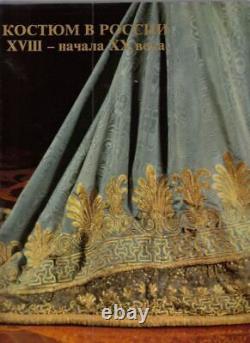
- Homepage
- Brand
- Function
- Min. Length
- Thread Size
- Type
- Back Door (34)
- Book (76)
- Composite Front Door (22)
- Cooling And Heating (19)
- Doors (36)
- Drive Shaft (425)
- External (4)
- French Door (138)
- Front Door (37)
- Front Entrance Door (12)
- Glass Door (10)
- Home Window (243)
- Panel Door (5)
- Paperback (7)
- Patio Door (19)
- Sliding Door (7)
- Textbook (35)
- Water Pump (4)
- Window (4)
- Wristwatch (18)
- ... (1560)
- Weight
Kostyum v Rossii XVIII nachala XX veka iz sobraniya gosudarstvennogo Ermitazha



Kostyum v Rossii XVIII - nachala XX veka iz sobraniya gosudarstvennogo Ermitazha. = "Costume in Russia 18th - Early 20th Centuries from the Hermitage Collection" = Kostüm in Russland, 18. Aus der Sammlung der Staatlichen Eremitage.
Originalleinen mit Schutzumschlag im Schuber (dieser leicht bestoßen) 279 S. Mit zahlreichen, überwiegend farbigen Abbildungen; 31 cm. Text russisch mit englischer Zusammenfassung.// The present album Costume in Russia. 18th-Early 20th Centuries is based on the materials of the magnificent collection of costumes now in the Department of the History of Russian Culture at the Hermitage Museum in Leningrad. The'beginnings of this collection date back to the first years after the October Revolution. Costumes of the former owners of nationalized palaces and mansions first entered the Department of Regional Studies at the Russian Museum and then, after being moved from one place to another, were finally transferred, in 1941, to the newly established Department of the Hermitage Museum mentioned above. The Hermitage also came into possession of the "wardrobe of Peter the Great", a remarkable collection of nearly three hundred items of men's clothes, including lavishly embroidered formal costumes - splendid specimens of the decorative and applied art of the early eighteenth century - and everyday garments made of cloth which could have been worn by common townspeople.
In addition, the Hermitage contains a small but noteworthy collection of merchant, lower middle-class and folk dresses, intended for holiday and daily use, which came from the collections of N. Galnbeck and others, or were assembled by the scientific expeditions of the Department of the History of Russian Culture in different parts of the Soviet Union. One of the most important recent acquisitions is the col-lection of V. Today the Hermitage collection boasts several thousands of clothing items and rates among the richest repositories of this kind both at home and abroad. The aim of this album is to show costume as an artistic phenomenon whose development is inseparably linked with the changes taking place in the general direction of art, with the changing of styles.
At the same time account is taken of the fact that costume always reflects the tastes of a definite stratum of society and is closely connected with the social, economic and cultural life of this or that period. In showing city dresses, for example, one should not ignore the fact that the brilliant workmanship of their creators weavers, tailors, embroiderers, lace-makers, etc. Manifested itself above all in the expensive apparel of the aristocracy. It is these garments that are most typical of the style of a certain period, that best reveal the artistic taste and mastery of their, as a rule, anonymous creators. While costumes of ordinary town-dwellers, the lower middle class and merchants tend to imitate the fashionable silhouette, they are plainer and have a less interesting decor as far as its artistic execution is concerned.The late seventeenth-early eighteenth century was a turning-point in Russian history. The Petrine reforms not only deeply affected the economic and political life of the country but also left a strong stamp on all aspects of Russian everyday life, the style of costume included.
The traditional dress of pre-Petrine Russia was replaced by costumes in the Western fashion. The first Petrine ukase (decree) on changing dress, issued in 1700, was followed by a number of others. The observance of the ukases was absolutely necessary, with heavy fines imposed on those who disobeyed. The essential lines of male dress introduced by Peter the Great were laid down in the late seventeenth century.
Borrowed from France, at the court of Louis XIV, this costume consisted of caftan (coat), jacket and trousers. The caftan was knee-length, close-fitting to the waist and flared out in skirts. The tall cuffs and the figured flaps of the pockets were furnished with buttons. The jacket was shorter than the caftan, without pleats and collar, and with long narrow sleeves.The trousers were short, just below the knee. Everyday dresses were made of cloth or linen and decorated with fabric of contrasting colour and buttons. Festive garments of wealthy townspeople employed more expensive fabrics, such as silk, velvet and brocade, and were trimmed with lace and embroidered with gold and silver threads. The reform also affected female costume.
Padded jackets and sarafans were abandoned for luxurious French gown-robes with tightly laced corsages, rather deep decolletage, elbow-length sleeves and wide skirts. Like men's dress, these gowns often had elaborate embroidery and lace-work. Kostüm; Kleidung; Rußland; Sammlung / Erimitage; Kunst / Kultur; Geschichte. Selbstverständlich können Sie den Titel auch bei uns abholen. Unsere Bestände befinden sich in Berlin-Tiergarten.
Bitte senden Sie uns eine kurze Nachricht! Sicheres Bestellen - Order-Control geprüft!

